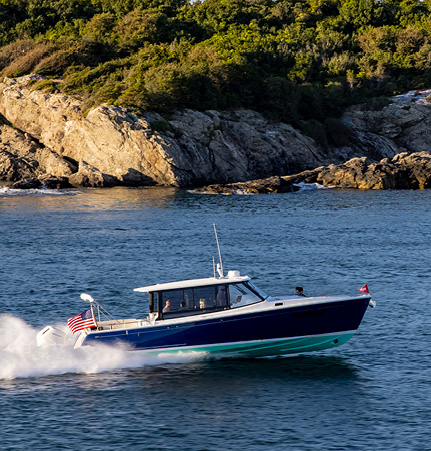By Buttons Padin

You want it darker: If you’re among the countless other lifetime sailors for whom the thought of owning a boat needing only lever movement to motivate is increasingly appealing, you could do worse than this MJM 4…and sign your family up for a safe boating class! © MJMYachts.com
Like many of my friends, I grew up sailing dinghies. As such, the lingo as kids was that powerboats, of any description, were “stink pots.” Now, when some sailor tells me they purchased a powerboat, they say they went over to the dark side. It’s funny how a sailor’s perception of powerboats will change with age as do the boats they go out on.
While I am still predominantly a sailor, the reality is that over the past decades, I have spent a lot of time operating powerboats. Starting as a junior sailing instructor then sailing on racer/cruisers with auxiliary engines, to a center-console I helped operate with a friend for a few seasons, to operating a rhib as a safety officer in local Opti regattas. While powerboaters may be able to avoid sails, it’s really tough for sailors to avoid powerboats.
We all see the occasional sailboat out there where the skipper clearly doesn’t know what he or she is doing. We see that with powerboats, too. And, while there is a lot to learn about sailing that may not come naturally, there are many, many aspects of operating a powerboat that are not intuitive. It’s not “just like driving a car.”
After a fatal accident in 2005 where 11-year-old Brianna Lieneck from Long Island was killed in a powerboat accident, New York State enacted in 2019 Brianna’s Law, a comprehensive boater education law requiring all powerboaters (including those operating sailing vessels with auxiliary power) to complete a boater safety course. This law has a gradual implementation by date of birth, but all powerboat operators in New York, regardless of age, will need a boating safety certificate beginning in January 2025. To earn this certificate, one must take an 8-hour safe boating course.
I had an open Sunday a few weeks ago, so I decided to get ahead of the rush and take the Boat America Safe Boating Course offered by the U.S. Coast Guard Auxiliary at my home yacht club. As the day began, I thought I already knew all the answers. As the day progressed, however, the occasional kernel of previously unknown powerboating wisdom came out. From subtle tips on firefighting at sea, to proper docking, passing other boats underway, and a reminder on proper anchoring, to servicing an engine, backing-up a trailer, and more, after eight hours I walked away with the impression that there is as much nuance to safe powerboating as there is in winning a race on a tweaky all-carbon sailboat.
My takeaway is that I’m glad I invested this time to become a better powerboating sailor. Even if you don’t operate a powerboat under New York’s Brianna’s Law, you still want to be a safe boater. As such, I strongly recommend that everyone invests the time, as a sailor or as a regular powerboater, and take a safe boating course. Oh, yes, those kernels I picked up helped me score a 97% in the post-class exam, and they also confirmed that the Dark Side isn’t really that dark. ■
Buttons Padin is an enthusiastic member of Larchmont Yacht Club and Storm Trysail Club.




